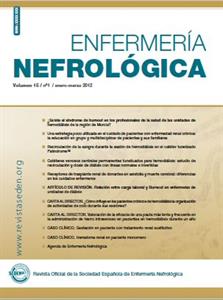Contenido del artículo principal
Resumen
El estudio se centra en la relación entre la posición anatómica de las puntas del catéter mediante radiografía de tórax y la recirculación medida con Dilución Ultrasónica, el Porcentaje de Reducción de Urea y el Kt/V, determinados tanto con líneas en posición normal e invertida y a flujos de bomba de 250 y 300 ml/min.
Material y método: Estudio Cuasiexperimental Intrasujeto de 18 meses de duración a n=28 catéteres implantados en 25 pacientes en Hemodiálisis.
Resultados:
• Recirculación:
• Líneas normales a 250 y 300 ml/min: 0,85 ± 2,41% y 1,23 ± 3,14%.
• Líneas invertidas a 250 y 300 ml/min; 22,41 ± 12,12% y 24,93 ± 12,09%.
• Porcentaje de Reducción de Urea:
• Líneas normales a 250 y 300 ml/min; 66,49 ± 8,62% y 70,55 ± 5,30%.
• Líneas invertidas a 250 y 300 ml/min; 61,05 ± 8,34% y 62,34 ± 8,68%.
• Kt/V:
• Líneas normales a 250 y 300 ml/min: 1,31 ± 0,30 y 1,46 ± 0,23%.
• Líneas invertidas a 250 y 300 ml/min: 1,10 ± 0,21% y 1,19 ± 0,30%.
Discusión: Los Porcentajes de Reducción de Urea y Kt/V con líneas invertidas a ambos flujos estudiados, manifiestan dosis de diálisis adecuadas asumiendo recirculaciones entorno al 20%.
Palabras clave
Detalles del artículo
Derechos de autor 2012 Antonio José Fernández Jiménez, Gustavo Samuel Aguilar Gómez, Irene Cabrera Plaza, Rocío Moulín Martín, Virginia Asunción Marín Fábrega, Tania Sánchez Orellana, Mª José Marqués Racionero, Mª Dolores Pérez Angulo, Encarnación Ortega Aranda, Julia Moya Ruiz, Aurora Ortega Aranda, Gema Perles Carracosa, Mª Mercedes Morillo Pedregosa, Ana Mª Ramos Serrano, Luisa Mª Sánchez Sánchez

Esta obra está bajo una licencia internacional Creative Commons Atribución-NoComercial 4.0.
Aviso de derechos de autor/a
© Los autores ceden de forma no exclusiva los derechos de explotación de los trabajos publicados y consiente en que su uso y distribución se realice con la Licencia Creative Commons Atribución - No comercial 4.0 Internacional (CC BY-NC 4.0). Puede consultar desde aquí la versión informativa y el texto legal de la licencia. Esta circunstancia ha de hacerse constar expresamente de esta forma cuando sea necesario.
Referencias
- Varios autores. Guía de acceso vascular en hemodiálisis. SEN. 2004.
- Nacional Kidney Foundation. K/DOQI Clinical Practice Guidelines for Vascular Access. Am J Kidney Dis 2001; 37 S137-S181.
- Crespo Montero R. et al. Estudio retrospectivo de las complicaciones de los catéteres temporales para hemodiálisis. Rev. Soc. Esp. Enferm. Nefrol.
- ; 14 (1): 43/49.
- Abdolamir Atapour, et al. Access Recirculation in Jugular Venous Catheter in Regular and Reversed Lines. Iranian Journal of Kidney Diseases. (2) 2:April 2008.
- Fernández-Quesada et al. Catéteres Centrales para Hemodiálisis.Angiología 2005; 57 (Supl. 2): S145-57.
- Senécal L, Saint-Sauveur E, Leblanc M. Blood flow and recirculation rates in tunneled hemodialysis catheters. ASAIO J. 2004 Jan-Feb; 50 (1):94-97.
- Dionisio P, Valenti M, Bergia R, et al. Evaluation of urea recirculation and dialysis efficiency of central venous yugular catheters when the venous lumen is used as an arterial lumen. Minerva Urol Nefrol. 1999;51:61-5. Italian.
- Casas R. et al. Evaluación de la recirculación en catéteres para hemodiálisis y su relación con laspresiones del circuito. Rev. Soc. Esp. Enferm. Nefrol. 2002; (6) 2: 15/18.
- Level C, et al. Performance of twin central venous catheters:influence of the inversion of inlet and outlet on recirculation. Blood Purif. 2002;20(2):182-
- Hassan HA, Frenchie DL, Bastani B. Effect of reversal of catheter ports on recirculation: comparison of the PermCath with Tesio Twin Catheter.
- ASAIO J. 2002 May-Jun; 48 (3):316-319.
- Szabo J, Locking-Cusolito H. The impact of increased blood flow rates on recirculation in central venous hemodialysis catheters. Nephrol Nurs J. 2001 Dec; 28 (6):639-641.
- Daugirdas JT, Blake PG, Ing TS. Handbook of Dialysis 4ª ed. Phhiladelphia: Lippincott Williams and Wilkins; 2007.
- Maduell F, García M, Alcázar R. Dosificación y adecuación del tratamiento dialítico. Guías SEN.
- Guías de centros de hemodiálisis. Nefrología 2006; 26 (Supl. 8): 15-21.
- Krivitski NM. Theory and validation of access flow measurement by dilution technique during hemodialysis. Kidney Internacional, 1995. 48, Jul: 244-250
Referencias
Varios autores. Guía de acceso vascular en hemodiálisis. SEN. 2004.
Nacional Kidney Foundation. K/DOQI Clinical Practice Guidelines for Vascular Access. Am J Kidney Dis 2001; 37 S137-S181.
Crespo Montero R. et al. Estudio retrospectivo de las complicaciones de los catéteres temporales para hemodiálisis. Rev. Soc. Esp. Enferm. Nefrol.
; 14 (1): 43/49.
Abdolamir Atapour, et al. Access Recirculation in Jugular Venous Catheter in Regular and Reversed Lines. Iranian Journal of Kidney Diseases. (2) 2:April 2008.
Fernández-Quesada et al. Catéteres Centrales para Hemodiálisis.Angiología 2005; 57 (Supl. 2): S145-57.
Senécal L, Saint-Sauveur E, Leblanc M. Blood flow and recirculation rates in tunneled hemodialysis catheters. ASAIO J. 2004 Jan-Feb; 50 (1):94-97.
Dionisio P, Valenti M, Bergia R, et al. Evaluation of urea recirculation and dialysis efficiency of central venous yugular catheters when the venous lumen is used as an arterial lumen. Minerva Urol Nefrol. 1999;51:61-5. Italian.
Casas R. et al. Evaluación de la recirculación en catéteres para hemodiálisis y su relación con laspresiones del circuito. Rev. Soc. Esp. Enferm. Nefrol. 2002; (6) 2: 15/18.
Level C, et al. Performance of twin central venous catheters:influence of the inversion of inlet and outlet on recirculation. Blood Purif. 2002;20(2):182-
Hassan HA, Frenchie DL, Bastani B. Effect of reversal of catheter ports on recirculation: comparison of the PermCath with Tesio Twin Catheter.
ASAIO J. 2002 May-Jun; 48 (3):316-319.
Szabo J, Locking-Cusolito H. The impact of increased blood flow rates on recirculation in central venous hemodialysis catheters. Nephrol Nurs J. 2001 Dec; 28 (6):639-641.
Daugirdas JT, Blake PG, Ing TS. Handbook of Dialysis 4ª ed. Phhiladelphia: Lippincott Williams and Wilkins; 2007.
Maduell F, García M, Alcázar R. Dosificación y adecuación del tratamiento dialítico. Guías SEN.
Guías de centros de hemodiálisis. Nefrología 2006; 26 (Supl. 8): 15-21.
Krivitski NM. Theory and validation of access flow measurement by dilution technique during hemodialysis. Kidney Internacional, 1995. 48, Jul: 244-250




